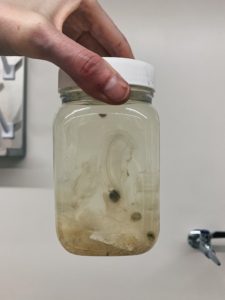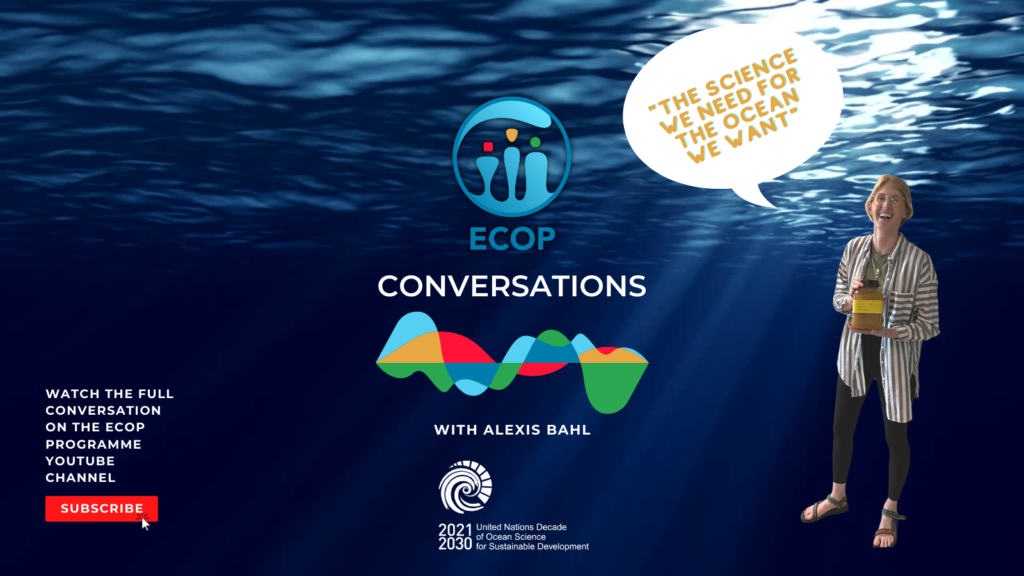Words by: Alexis Bahl
Every night when the sun sets, the world’s largest migration takes place (Freer and Hobbs, 2020; Hays et al., 2003). From the deep, dark depths of the ocean (200-1000 m), enormous colonies of barrel-shaped, gelatinous organisms ranging in size from 5-75 mm, respectively, migrate hundreds of meters to the upper ocean (Pakhomov et al., 2018). And then upon sunrise, they descend back into the cold water depths. These unique creatures, formally known as Salpa thompsoni, are commonly referred to as salps: a type of zooplankton with a behavioural trait to undergo this migration phenomenon known as diel vertical migration (DVM; diel meaning daily). Regarded as the most successful filter-feeder in the Southern Ocean (Foxton, 1966; Pakhomov et al., 2006; Henschke and Pakhomov, 2018; Stukel et al., 2021), the widespread occurrence of salps in the Southern Ocean is postulated to influence the vertical fluxes of key nutrients, carbon, and oxygen – all of which the residing food web and ecosystem rely upon for regulation.
In an effort to better understand the impact of salp DVM on Southern Ocean ecosystem processes, Alexis Bahl and her team from the University of British Columbia will embark on an expedition to the south Atlantic sector of the Southern Ocean aboard the Alfred Wegener Institute’s Polarstern research vessel, from October 1st to November 17th. With 30+ additional scientists, Alexis Bahl’s team is just one of 11 that will contribute to the expedition’s focus, “the island impact”, and work under the leadership of Dr. Christine Klaas to improve the scientific understanding of biogeochemistry and ecosystem function. The macrozooplankton and micronekton team, led by EOAS UBC professor, Evgeny Pakhomov, comprises of Lora Pakhomov, Alexis Bahl, and Florian Lueskow, with a particular interest in collecting the most abundant tunicate species in the Southern Ocean, Salpa thompsoni, with nets and observing its migratory behavior with acoustics and an underwater camera. Funded by the National Geographic Society, this research aims to answer the following questions: Are salp DVM occurrences a significant contributor to carbon export processes in the South Atlantic sector of the Southern Ocean? To what depths are salps residing during the day and are increasing water temperatures influencing their migratory behaviour? Lastly, how is the deep-sea community affected by salp DVM?
This expedition comes ten years after the 2012 Polarstern expedition to the same region where research findings pointed toward changing productivity. The unique opportunity to return and look more closely at various controls on biogeochemical processes will contribute to the knowledge of the Southern Ocean and its role in global climate.
Visit our Youtube channel to watch Alexis in “ECOP conversations” and learn more about her expedition to the Southern Ocean.


References:
Freer, J. & Hobbs, L. (2020). DVM: The World’s Biggest Game of Hide-and-Seek. Front. Young Minds. 8:44. doi: 10.3389/frym.2020.00044
Foxton, P. (1966). The distribution and life-history of Salpa thompsoni Foxton with observations on a related spccies, Salpa gerlachei Foxton, Discovery Rep., 34, 1-116.
Hays, G. C. (2003). A review of the adaptive significance and ecosystem consequences of zooplankton diel vertical migrations. Hydrobiologia, 503, 163–170. https://doi.org/10.1023/B:HYDR.0000008476.23617.b0
Henschke, N., Pakhomov, E. A., Groeneveld, J., & Meyer, B. (2018). Modelling the life cycle of Salpa thompsoni. Ecological Modelling, 387, 17–26. https://doi.org/10.1016/j.ecolmodel.2018.08.017
Pakhomov, E., Pakhomova, L., Iversen, M. H., Wegener, A., Flintrop, C., & Pauli, N.-C. (2018). BIOLOGY OF THE PELAGIC TUNICATE, SALPA THOMPSONI, IN THE WESTERNATLANTIC SECTOR OF THE SOUTHERN OCEAN DURING MARCH-MAY 2018. Retrieved from https://www.researchgate.net/publication/329352298
Pakhomov, E. A., Dubischar, C. D., Strass, V., Brichta, M., & Bathmann, U. V. (2006). The tunicate Salpa thompsoni ecology in the Southern Ocean. I. Distribution, biomass, demography and feeding ecophysiology. Marine Biology, 149(3), 609–623. https://doi.org/10.1007/s00227-005-0225-9
Stukel, M. R., Décima, M., Selph, K. E., & Gutiérrez-Rodríguez, A. (2021). Size-specific grazing and competitive interactions between large salps and protistan grazers. Limnology and Oceanography, 66(6), 2521–2534. https://doi.org/10.1002/lno.11770

